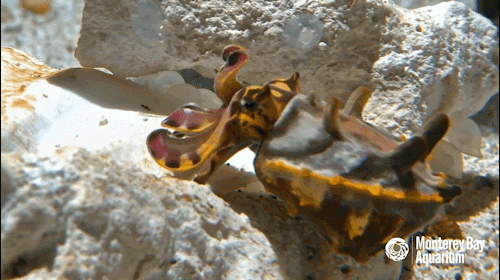What’s it Take to Raise a Rare Cuttlefish?
The Aquarium has successfully raised and displayed the common cuttlefish (Sepia officinalis) and the pharaoh cuttlefish (Sepia pharaonis). But now our aquarists are hoping to exhibit a rare and striking new species, the flamboyant cuttlefish (Metasepia pfefferi).
Only two other aquariums have displayed this colorful species before. Native to coastal mudflats in northern Australia, the flamboyant cuttle has been traditionally difficult to obtain and exhibit. “It’s not easy to find in the wild,” says Bret Grasse, the aquarist overseeing the project. “Cephalopods in general are hard to ship. They’re very sensitive. We’ve been trying to get the species for years.”
Help came from the Long Island Aquarium and Exhibition Center (formerly Atlantis Marine World) in New York, which sent eight subadults. Of these, staff isolated what they thought were two females and one male. Sure enough, they observed mating, and soon after, eggs were laid. “We were able to raise subadults to an adult stage, and then they had babies of their own,” says Bret.
One challenge has always been the delicate nature of the gossamer-looking animals. So Bret developed a cushioned netted enclosure to keep them safe, which fits inside a larger display. It worked. Currently, he has 10 juveniles behind the scenes. “That makes us only the second aquarium to successfully raise hatchling from eggs in captivity,” says Bret. “Long Island being the first.”
All of the juvenile cuttles are healthy, and Bret’s hopeful that a future generation will go on exhibit one day.
Cuttlefish Facts
Unlike other cuttlefish species, the flamboyant cuttlefish doesn’t dart away when threatened. It remains stationary, flashes its hypnotic color scheme and pulses its fins. While the flamboyant cuttle isn’t poisonous to the touch, some researchers believe they would be harmful, maybe deadly, if ingested. They live about a year, and eat a variety of foods. Babies are fed mysid shrimp and artemia, and adults are fed fish, crabs and shrimp. They can grow to about 10 centimeters, which is half the size of the two other cuttlefish species.
But the most impressive thing, says Bret, is the color. “Within seconds of emerging from the egg, they show these beautiful dark markings contrasting with brilliant pink tentacles. It’s incredible—unmatched in the animal kingdom!”
Bret’s become the Aquarium’s cuttle keeper since starting at the Aquarium two years ago. “I guess I’ve found my niche,” he says. “We’ve raised over 10 generations of pharaoh cuttlefish, and now two generations of flamboyant cuttlefish. It gives me great satisfaction.
“It’s also aligned with the mission of the Aquarium, and our desire not to remove wild stock from the oceans. We’ve cultured and given away well over 1,000 cuttlefish to other institutions!”
-Geoff Drake, Senior Web Writer






